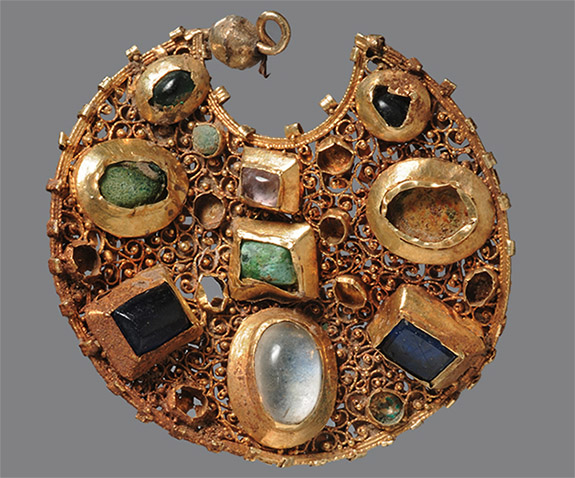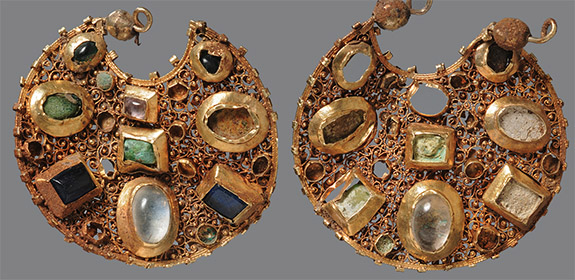March 7th, 2023
A volunteer-in-training at the UNESCO World Heritage Site of Haithabu in northern Germany startled his mentors when he unearthed a spectacular pair of 800-year-old gem-set pendant earrings on just his third day using a metal detector.

Nicki Andreas Steinmann's instructor had assigned him to scan a quadrant in an area that is now a working farm, but was once part of a Viking trade center and settlement from the 8th to 11th centuries. Haithabu had been destroyed and abandoned around 1066, ending the Viking era in the region.
About 200 years later, a traveler likely buried the Byzantine-style gold earrings, along with silver coins and other gold jewelry, in a fabric bag and never came back to claim them.

The pendant earrings, which are in remarkably good shape considering they've been buried for eight centuries, each featured 19 colored gemstones of varying sizes. Many of the larger stones are still secure in their bezel settings. The earrings measure about 5 cm in diameter and display an openwork filigree motif.
After Steinmann and his mentors reported the find to state officials, the State Archaeological Department of Schleswig-Holstein (ALSH) conducted a controlled excavation of a 4-square-meter area.
The archaeologists recovered a gilded brooch made to look like an Islamic coin, two gilded rings set with stones, a ring fragment, a gilded perforated disc, a ring brooch and 30 silver coins minted during the reign of Danish King Valdemar II, between 1202 and 1241.
Officials at ALSH noted that it's unclear whether these items were personal property or stolen, if they were meant to be delivered to someone else, or if they were buried for ritual reasons or because of an imminent threat.
According to Live Science, amateur and professional archaeologists have been working together for decades to investigate the Haithabu site in the region of Schleswig-Holstein, Germany's northernmost state.
UNESCO World Heritage Sites are places that are listed as having special cultural or physical significance by the United Nations Educational, Scientific and Cultural Organization (UNESCO).
Credit: Photos courtesy of the Archaeological State Office of Schleswig-Holstein.

Nicki Andreas Steinmann's instructor had assigned him to scan a quadrant in an area that is now a working farm, but was once part of a Viking trade center and settlement from the 8th to 11th centuries. Haithabu had been destroyed and abandoned around 1066, ending the Viking era in the region.
About 200 years later, a traveler likely buried the Byzantine-style gold earrings, along with silver coins and other gold jewelry, in a fabric bag and never came back to claim them.

The pendant earrings, which are in remarkably good shape considering they've been buried for eight centuries, each featured 19 colored gemstones of varying sizes. Many of the larger stones are still secure in their bezel settings. The earrings measure about 5 cm in diameter and display an openwork filigree motif.
After Steinmann and his mentors reported the find to state officials, the State Archaeological Department of Schleswig-Holstein (ALSH) conducted a controlled excavation of a 4-square-meter area.
The archaeologists recovered a gilded brooch made to look like an Islamic coin, two gilded rings set with stones, a ring fragment, a gilded perforated disc, a ring brooch and 30 silver coins minted during the reign of Danish King Valdemar II, between 1202 and 1241.
Officials at ALSH noted that it's unclear whether these items were personal property or stolen, if they were meant to be delivered to someone else, or if they were buried for ritual reasons or because of an imminent threat.
According to Live Science, amateur and professional archaeologists have been working together for decades to investigate the Haithabu site in the region of Schleswig-Holstein, Germany's northernmost state.
UNESCO World Heritage Sites are places that are listed as having special cultural or physical significance by the United Nations Educational, Scientific and Cultural Organization (UNESCO).
Credit: Photos courtesy of the Archaeological State Office of Schleswig-Holstein.


